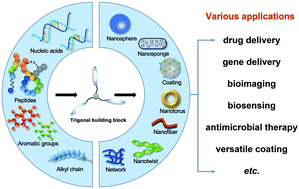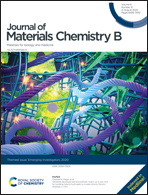Self-assembly of trigonal building blocks into nanostructures: molecular design and biomedical applications
Abstract
Trigonal molecules have a special triskelion structure similar to clathrin protein, providing great inspiration for constructing artificial nanoassemblies. To date, various synthetic trigonal conjugates have been designed for supramolecular self-assembly, which have demonstrated versatile and controllable self-assembly ability in materials science. Here we will review the design of trigonal (sometimes called three-legged, tripodal, C3-symmetric, or triskelion) building blocks that can self-assemble into various nanostructures and discuss the biomedical applications of the self-assembled nanomaterials.

- This article is part of the themed collection: Journal of Materials Chemistry B Emerging Investigators


 Please wait while we load your content...
Please wait while we load your content...